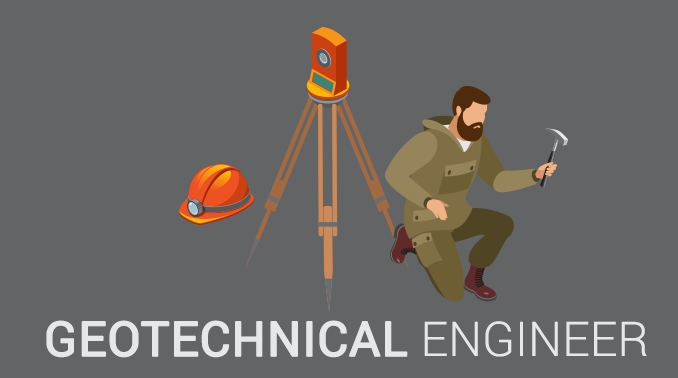Getting The Geotheta To Work
Getting The Geotheta To Work
Blog Article
Geotheta for Beginners
Table of ContentsNot known Details About Geotheta Top Guidelines Of GeothetaExamine This Report on GeothetaTop Guidelines Of Geotheta
They team up with civil engineers, structural designers, architects, and other specialists to integrate geotechnical factors to consider into the overall task layout and construction procedure. This needs efficient team effort, control, and communication to make certain that the geotechnical facets align with the job purposes and fulfill regulatory requirements.Mining & Products Design: Concepts of drilling, penetration rates, and variables impacting the choice of boring technique. Characteristics of dynamites, firing systems and blast patterns. Blasting techniques in surface area and below ground workings. Special blowing up strategies at excavation borders. Vibration and noise control. Mechanical and continual approaches to fragmentation, consisting of longwall shearing and fullface boring.
Modelling of fragment and bit dimension circulations; comminution as a transfer feature. Comminution modern technology: crushing, grinding, size classification. Integrated evaluation of fragmentation and comminution operations. Provided by: Mining & Products Engineering.
The Basic Principles Of Geotheta
Bachelor's level programs in civil, geotechnical, geological, and environmental engineering normally last four years and consist of general education training courses in English, social science, and the humanities, as well as training courses in innovative mathematics, architectural geology, and liquid mineralogy. (https://www.easel.ly/browserEasel/14498559)
Geotechnical engineering includes the analysis of the soil and rock problems at a certain website, and their implications for the development of that site. As the majority of frameworks count on the ground for assistance, it lacks shock that a detailed understanding of the ground problems, and the suitability of foundation systems, are crucial to the long-lasting stability and performance of the structure or structure.
Specialising in the examination of geological formations and ground behavior, geotechnical engineers execute clinical examinations and testing to recognize the effect these geological formations might carry the design and building of building, civil and facilities projects. This know-how is important for the style and building and construction of buildings, roadways, tunnels, dams, bridges, and supply of water and sewage systems.
The geotechnical team at Douglas Partners consistently speak with engineers, style engineers, designers, and home builders to make recommendations on design and advancement proposals to guarantee that the built structures are accordingly made for the ground conditions. For example, the style of footing systems needs to think about the weight of the structure, the ability of the ground to support that weight along with activity tolerances and effective construction.
The Basic Principles Of Geotheta
This job is greatly streamlined by the use our Douglas Map geospatial platform that makes this details readily accessible in a very easy to utilize web browser interface. A geotechnical designer will guide the boring of boreholes and examination pits to gather dirt and various other samples, and additionally examine surface area attributes and ground direct exposures to form a geotechnical design of the subsurface conditions.
Depending on the job type and ground problems encountered, lab testing might amongst other points evaluate toughness, compressibility, sensitivity and/or leaks in the structure of soil and rock examples. Hereafter information is collected and collated, the results are utilized for a geotechnical model of the website, which is usually offered as sections across the site.

A geotechnical investigation naturally can just evaluate the ground problems at the areas drilled or dug deep into. All-natural variants in dirt and rock conditions can occur across a website and between examination areas. It is consequently excellent technique that the geotechnical engineer be kept throughout construction of the job to give on-site confirmation that the ground conditions come across are regular with the assumptions and recommendations supplied in the geotechnical investigation record.
All About Geotheta
Geotechnical designers utilize their comprehensive understanding of dirt and rock to assess risk and fix problems on varied infrastructure projectsGeotechnical engineering is a specialist branch of civil engineering which considers the behaviour of earth products and the application of soil and rock auto mechanics. Geotechnical Engineers. As a geotechnical designer, you will evaluate the physical, mechanical and chemical residential or commercial properties of dirt and rock in order to develop structures, retaining frameworks and earthworks
Geotechnical engineering is very closely linked to and overlaps with, both engineering geology and ground design - https://www.imdb.com/user/ur185987626/?ref_=nv_usr_prof_2. It's possible to be experts in geotechnics or help a geotechnical company but be called a design geologist or a ground designer. As a geotechnical designer, you'll need to: construct and preserve relationships with clients and various other experts associated with the website, throughout each projectmaintain security standards on website be conscious of price ramifications when you make recommendationsstudy geological maps and aerial photographs from a series of sources and from various time periodsexamine building and construction prepares to see just how practical they are based upon your understanding of the siteinvestigate dangers or geological risks for the sitesearch for eco sensitive functions, such as garbage dump begin to develop factual and interpretive ground modelsplan area investigationsdrill and evaluate examples of bedrock, dirt, groundwater and added products supervise various other experts on sitesolve technological issues as they develop, such as unexpected frameworks at drill sitesmonitor problems during and after building and construction to make certain frameworks are steady in the short and long termadding data gathered on website to your initial researchcreating geotechnical estimations, drawings, and two or three-dimensional computer system models translating the datamaking suggestions regarding the recommended use the website

Report this page